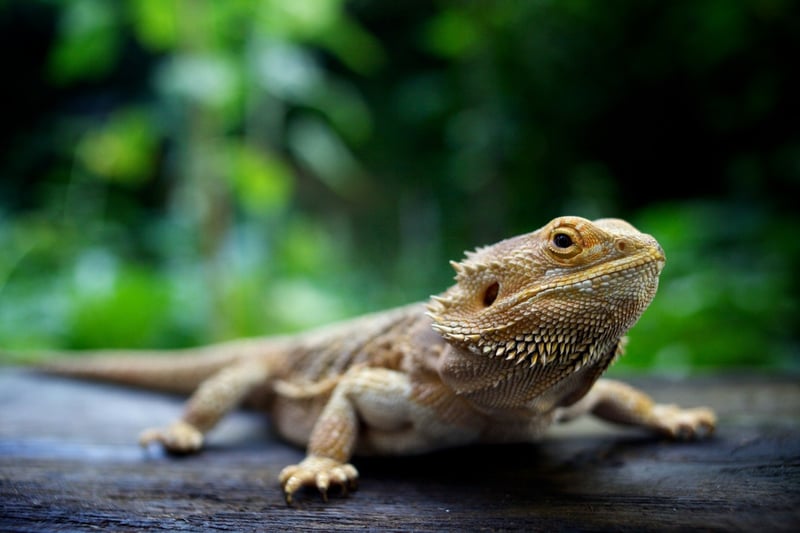
Like all reptiles, bearded dragons belong in the wild, not in a tank in your living room.
Though the bearded dragon’s natural habitat is in the warm, arid deserts and scrublands of Australia, they’re captively bred and sold as pets at major retailers in the US, including PetSmart and Petco.
While there are eight species of bearded dragons, the central bearded dragon (Pogona vitticeps) is most commonly kept as a pet. Despite their popularity (and the big bucks that pet stores make from selling them), bearded dragons can’t thrive in human homes. Here are four reasons why bearded dragons aren’t good pets:
1. Bearded dragons are bred in cruel reptile mills to supply pet stores
Australia banned the export of bearded dragons more than 50 years ago, but they’re sold by stores and online in the US thanks to reptile mills that churn out bearded dragons and other reptiles and amphibians by the thousands. Reptile and amphibian mills are not regulated by the federal government because the Animal Welfare Act excludes cold-blooded animals, leaving these animals vulnerable to extreme neglect and suffering.
Just like at puppy mills, veterinary care is rare or nonexistent at reptile mills. Overcrowding and poor sanitation are common, and a high mortality rate is seen as the cost of doing business. When you purchase a bearded dragon (or any animal) from a store or online, you’re inadvertently supporting a cruel industry that is indifferent to the suffering of animals.
2. Captive bearded dragons require temperature control and UVB lighting
Bearded dragons are cold-blooded and rely on external heat sources (like the sun) to regulate their body temperature. Unless you naturally keep parts of your house at 100 degrees Fahrenheit at all times, bearded dragons need a tank outfitted with a basking area as well as space provided for them to cool off. If the animal’s tank is indoors, they also need an artificial source of UVB (ultraviolet) light. Without it, bearded dragons cannot synthesize vitamin D effectively and will not absorb calcium properly.
If these sound like run-of-the-mill requirements for captive reptiles, you’re right. Most reptiles kept in captivity require terrariums or tanks that provide some kind of temperature control or light supplementation. Bearded dragons are often touted as “easier” reptiles because their care requirements are often less than other reptile species. But in reality, they aren’t easy to care for in a person’s home!
Instead, it underscores how broken our relationships with wild animals are. It’s become normal to keep an animal in a tank where they’d die if we didn’t keep the temperature artificially increased. In the wild in Australia, a bearded dragon doesn’t need heat lamps and vitamin supplements. She just needs the sun on her back and dirt to burrow in when she gets too hot.
3. Bearded dragons’ natural behaviors are restricted in captivity
In the wild, bearded dragons roam the Australian countryside, basking in the sun and digging tunnels and caves to hide out in and cool off. They choose who to mate with and what to eat. In your home, those activities are either impossible or severely restricted. As noted above, bearded dragons can’t thrive spending all their time hanging out on your couch either. Remember, they’re roughly 10,000 miles from their natural habitat in Australia. They need external heat sources and special lights just to survive.
4. Bearded dragons can transmit serious diseases
Reptiles and amphibians kept as pets are a significant source of Salmonella infection in humans. The bacteria is found in the digestive tracts of healthy reptiles, but it can cause severe illness or even death in humans. The elderly and young children are particularly susceptible. Because Salmonella is shed in animals’ droppings and spreads easily to anyone who touches the animal or their habitat, the Centers for Disease Control and Prevention cautions families against keeping reptiles and amphibians in homes with children under the age of five. In the fall of 2020, 18 people across 11 states were infected with Salmonella from bearded dragons kept as pets. 11 people required hospitalization.
Due to reptile mills and impulsive purchases at pet stores, there are now many bearded dragons in need of adoption. Compassionate people can provide the next best thing to a wild life by adopting a bearded dragon from a shelter or rescue and providing as much space and freedom as possible. But to truly protect these animals, we need to stop their sale and work to ensure all future bearded dragons live in the wild. Tell PetSmart to stop supporting the wildlife trade and phase out the sale of reptiles and amphibians in their stores.